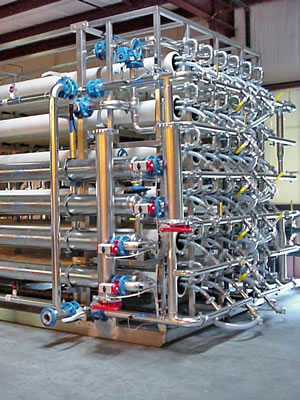ROS-Series Reverse Osmosis System
Osmosis is the tendency of a fluid to equalize the concentration of dissolved minerals on either side of a semi-permeable membrane.
The osmotic flow can be slowed or stopped by applying pressure to the more concentrated side. The exact pressure required to stop this flow is the osmotic pressure. With sufficient pressure to overcome the osmotic pressure, the flow through the membrane is reversed. This is the principal of Reverse Osmosis (RO).
In water treatment, Reverse Osmosis (RO) is a simple process in which water under pressure is forced through a semi-permeable membrane. When pressure on the order of 200-600 PSIG is applied, most of the water (at least 75%) will pass through the semi-permeable membrane while most of the dissolved solids (approximately 98%) will be retained. The water (permeate) is captured as demineralized water, with the balance rejected (concentrate), containing water, dissolved minerals, particulate matter, and organics. A typical system will produce 75% product water and 25% concentrated waste solution. In other words, for every hundred gallons of feed water input, the system will produce seventy-five gallons of permeate water and twenty-five gallons of concentrate. To obtain higher water purity, the permeate water can be passed through a 2nd RO membrane, reducing dissolved minerals to 0.04% of the original water quality.
All RO systems are custom designed to suit each application with primary importance placed on the selection of the appropriate membrane for the application. System construction contains the following standard features:
- Brushed Stainless Steel or epoxy coated carbon steel frame
- Stainless Steel cartridge pre-filter to reduce the size of suspended solids to under 5 micron.
- A 316 stainless steel high pressure pump to boost the feed water pressure to the required applied pressure.
- Fiberglass pressure vessels housings for RO membranes.
- High pressure piping fabricated from schedule 10 or schedule 40 316L stainless steel; low pressure piping from schedule 80 PVC.
- Valving for pneumatically actuated and manual isolation valves consists of ball valves on line sizes 2î and smaller; butterfly valves on larger lines.
- Throttling valves are globe style.
- A PLC controller to automate the system.
- Completely factory assembled and tested.
- Instrumentation to monitor flow, pressure, conductivity and temperature for the feed, concentrate and reject streams.
- Automation Delete
- Complete Stainless Steel or Alloy Piping
- Custom Instrumentation
- Valve Upgrades
- Multiple / Alternating Units
- High Recovery
- Concentrate Recycle
- Product Recirculation
- Product Stage (Two-Pass)
- Seawater
- Automatic Sanitization
- Product Divert
- Stainless Steel Pressure Vessels
- ASME Code Pressure Vessels
- VFD Drive
- Expandable Configuration
